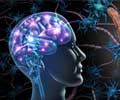Names forever linked to what they represent: Alzheimer's, Huntington's, Parkinson's: diseases that ravage the brain's neurons and leave entire regions to wither and die.

In the latest issue of Nature Chemical Biology, researchers in the laboratory of Gladstone Investigator Steve Finkbeiner, MD, PhD, describe how a newly developed technology allowed them to see—for the first time—how individual neurons fight back against the buildup of toxic proteins over time. Focusing their efforts on a model of Huntington's disease, the team observed how different types of neurons in the brain each responded to this toxic buildup with different degrees of success, offering clues as to why the disease causes neurons in one region to die, while neurons in another are spared.
"Huntington's—an inherited and fatal disorder that leads to problems with muscle coordination, cognition and personality—is characterized by the toxic buildup of a mutant form the huntingtin protein in the brain," explained Dr. Finkbeiner, who directs the Taube-Koret Center for Neurodegenerative Disease Research at Gladstone. Dr. Finkbeiner is also a professor of neurology and physiology at the University of California, San Francisco, with which Gladstone is affiliated. "A long-standing mystery among researchers was how the buildup of the mutant huntingtin protein caused cells to degrade and die, but previous technology made it virtually impossible to see and monitor this process at the cellular level. In this study, we employed a method called optical pulse-labeling, or OPL, which allowed us to see how the mutant huntingtin ravaged the brain over time—neuron by neuron."
Using neurons extracted from rodent models of Huntington's, the team employed the OPL method, which monitored the speed and efficiency with which different types of neurons were able to flush out the mutant huntingtin. The faster a cell could clear out the toxins, the longer the neuron survived, and vice versa.Surprisingly, the research team noticed clear differences in the ability of different types of neurons to clear mutant huntingtin. Neurons located in the striatum—the region of the brain primarily affected by Huntington's disease that is involved in muscle movement—were particularly susceptible. Neurons found in other regions, such as the cortex and cerebellum, were less so. And when they tracked the striatal neurons carrying the mutant huntingtin, they found them much more likely to die than those from other brain regions.
All cells depend on two main processes to clear excess proteins: the ubiquitin-proteasome system (UPS) and autophagy. Although their mechanisms are distinct, their goal is the same: to literally gobble up excess proteins, ensuring they are efficiently flushed out so as to not to interfere with normal cellular activity.The research team found that striatal neurons were particularly sensitive to disruptions to the autophagy process. But the team found a way around this problem. They artificially accelerated autophagy by boosting the activity of a protein called Nrf2 in these neurons, which prolonged cell survival.
"If we could develop drugs that boost Nrf2 production in the neurons most susceptible to Huntington's, we might extend their survival, thereby staving off the worst effects of the disease," said former Gladstone Postdoctoral Fellow Andrey Tsvetkov, PhD, the study's lead author. "Importantly, our results also demonstrate that the brain itself has evolved powerful coping mechanisms against diseases such as Huntington's. For example, the fact that people don't start experiencing symptoms of Huntington's until the fourth or fifth decade of their lives—even though the mutant huntingtin is present at birth—is further evidence of the brain's ability to stave off the effects of the disease."
Advertisement
Source-Eurekalert












